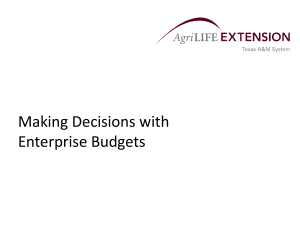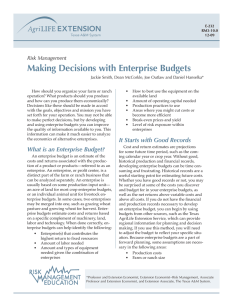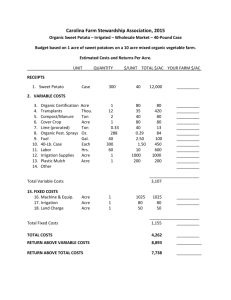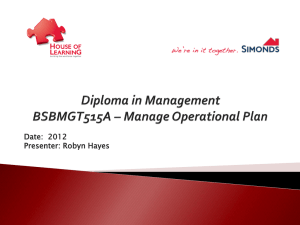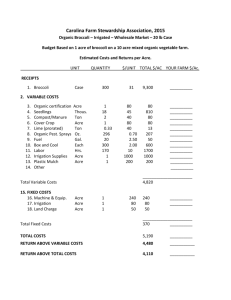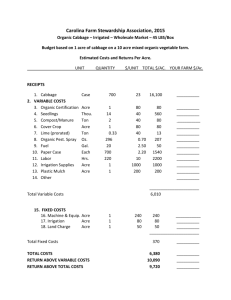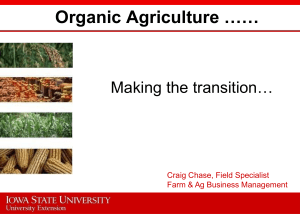Making Decisions with Enterprise Budgets
advertisement
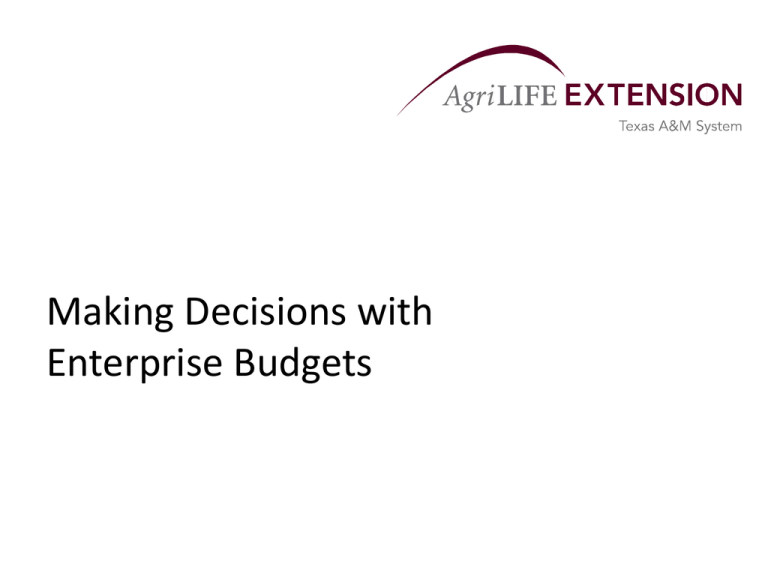
Making Decisions with Enterprise Budgets What is an Enterprise Budget? An enterprise budget is an estimate of the costs and returns associated with the production of a product or products – referred to as an enterprise. An enterprise, or profit center, is a distinct part of the farm or ranch business that can be analyzed separately. An enterprise is usually based on some production input unit – an acre of land for most crop enterprise budgets, or an individual animal unit for livestock enterprise budgets. Enterprise budgets estimate costs and returns based on a specific complement of machinery, land, labor and technology. Enterprise Budgets Can Help Identify the Following Enterprise(s) that contribute the highest return to fixed resources. Amount of labor needed. Amount and types of equipment needed given the combination of enterprises. How to best use the equipment on the available land. Amount of operating capital needed. Production practices to use. Areas where you might cut costs or become more efficient. Break-even prices and yield. Level of risk exposure within enterprises. Recordkeeping for Enterprise Budgets Cost and return estimates are projections for some future time period, such as the coming calendar year or crop year. Without good, historical production and financial records, developing enterprise budgets can be time consuming and frustrating. Historical records are a useful starting point for estimating future costs. If a producer does not have the financial and production records necessary to develop an enterprise budget, you can begin by using budgets from other sources, such as the Texas AgriLife Extension Service, which can provide regional information for planning and decision making. Because enterprise budgets are a part of forward planning, some assumptions are necessary in the following areas: Production costs Farm or ranch size Types of enterprises available Types of operations and technology involved in production Types of machinery and equipment needed Soil productivity and yield potential Forage quality and quantity Operating capital available Inventory of machinery, land and labor Types of Costs Costs are sometimes broken into two groups, referred to as variable and fixed costs, direct and indirect costs, or operating and overhead costs. Variable costs vary with the size of the enterprise (number of head, acres, etc.) and with the management decisions made, such as the type of field and tillage operations that will occur. Variable costs occur because of the decision to purchase additional inputs for use in production. In the long run, all costs are variable, and at a point in time near the end of the production period, almost all costs are fixed. Fixed costs are those costs the business is committed to pay regardless of the actions taken during the current planning period. Producers who have already invested in land, machinery, and buildings are committed to owning these resources for the upcoming production period or year. There are certain fixed costs associated with these resources that the producer will incur whether or not there is any production. Fixed costs include depreciation and insurance on machinery, equipment, and buildings, interest on machinery, equipment, buildings and land; and land taxes. Types of Costs cont. Both fixed and variable costs are considered when deciding whether to continue production. In the short run the amounts of some inputs can be changed, while others cannot. Generally, all inputs, including land, can be changed in the long run. In the short run (when at least some costs are fixed), the producer should stay in production if it appears that revenue will at least cover variable costs. However, if variable costs cannot be covered, continued production, even in the short run, only makes things worse. In the long run (when all costs can be varied), a farmer or rancher should continue production only if all costs can be covered. Anything short of that usually results in cash flow deficits and the erosion of net worth. Sometimes it is useful for producers to separate variable costs into preharvest and harvest costs. Using Enterprise Budgets Enterprise budgets require less data than the whole farm budget, and when realistic and accurate cost allocations can be made by enterprise, the comparative profitability of enterprises can be measured. Enterprise budgets also can be used to derive break-even prices and break-even yields. Developing Enterprise Budgets A variety of information sources are used to develop an enterprise budget. Rely on your own records if you are evaluating an existing enterprise, but use outside data to evaluate a new enterprise. When enterprise budgets are developed for the first time, records from the whole farm or ranch are usually the starting point. The allocation of costs to the individual enterprises is an important step in the development of useful enterprise budgets. Some costs are easily allocated, but for certain indirect costs it is not always clear how the allocation should be made. The key to allocating cost is to not distort relationships so that one would be misguided in choosing between enterprises. Table 1. Example Enterprise Budget for Dryland Sorghum Gross income from production Grain sold Total Gross Income Variable costs Pre-harvest costs Herbicide & custom application Seed Fertilizer-nitrogen Custom fertilizer application Fuel & lube Repairs Labor Interest on operating capital* Total Pre-harvest costs Harvest costs Custom combining Custom hauling Total Harvest Costs Total Variable Costs Gross Income minus Variable Costs Break-even grain price minus variable costs Fixed Costs Machinery and equipment Land – cash rent Total Fixed Costs Total Costs Net Projected Returns Break-even grain price minus total costs Quantity Unit $/Unit Total 18.0 cwt $6.50 $117.00 $117.00 1.0 2.25 40.0 1.0 1.0 1.0 1.0 1.0 Acre Lbs. Lbs. Acre Acre Acre Acre Acre $10.50 $1.25 $0.60 $4.50 $11.00 $15.25 $10.00 $2.29 $10.50 $2.81 $24.00 $4.50 $11.00 $15.25 $10.00 $2.29 $80.35 1.0 18.0 Acre Cwt $12.60 $0.25 $12.60 $4.50 $17.10 $97.45 $19.55 $5.41 1.0 1.0 Acre Acre $27.80 $20.00 $27.80 $20.00 $47.80 $145.25 ($28.25) $8.07 *Interest cost is based on all pre-harvest costs being borrowed for 6 months. Using Enterprise Budgets with Your Marketing Plan If an enterprise budget is being used in the development of a marketing plan, you could consider how much higher the break-even price would have to be to also cover a share of family living costs and/or some specified profit margin. To get the most out of enterprise budgeting, you must make an effort to determine which factors are likely to change and which ones have a major effect on profitability. The effect of different combinations of yields and prices should certainly be analyzed. When doing these “what if” scenarios on yield and price, also factor in an estimate for any applicable loan deficiency payments and crop insurance indemnities. Summary Enterprises are the basic building blocks for a farm plan. An enterprise budget is a summary of projected income and expenses associated with producing one unit of the enterprise. Such a budget can help you decide which enterprises will be more profitable and how to best use your available resources. It can be useful in deciding whether to add new enterprises or eliminate or change existing enterprises. The enterprise budget is, however, only the first step in evaluating an enterprise and developing a marketing plan.
